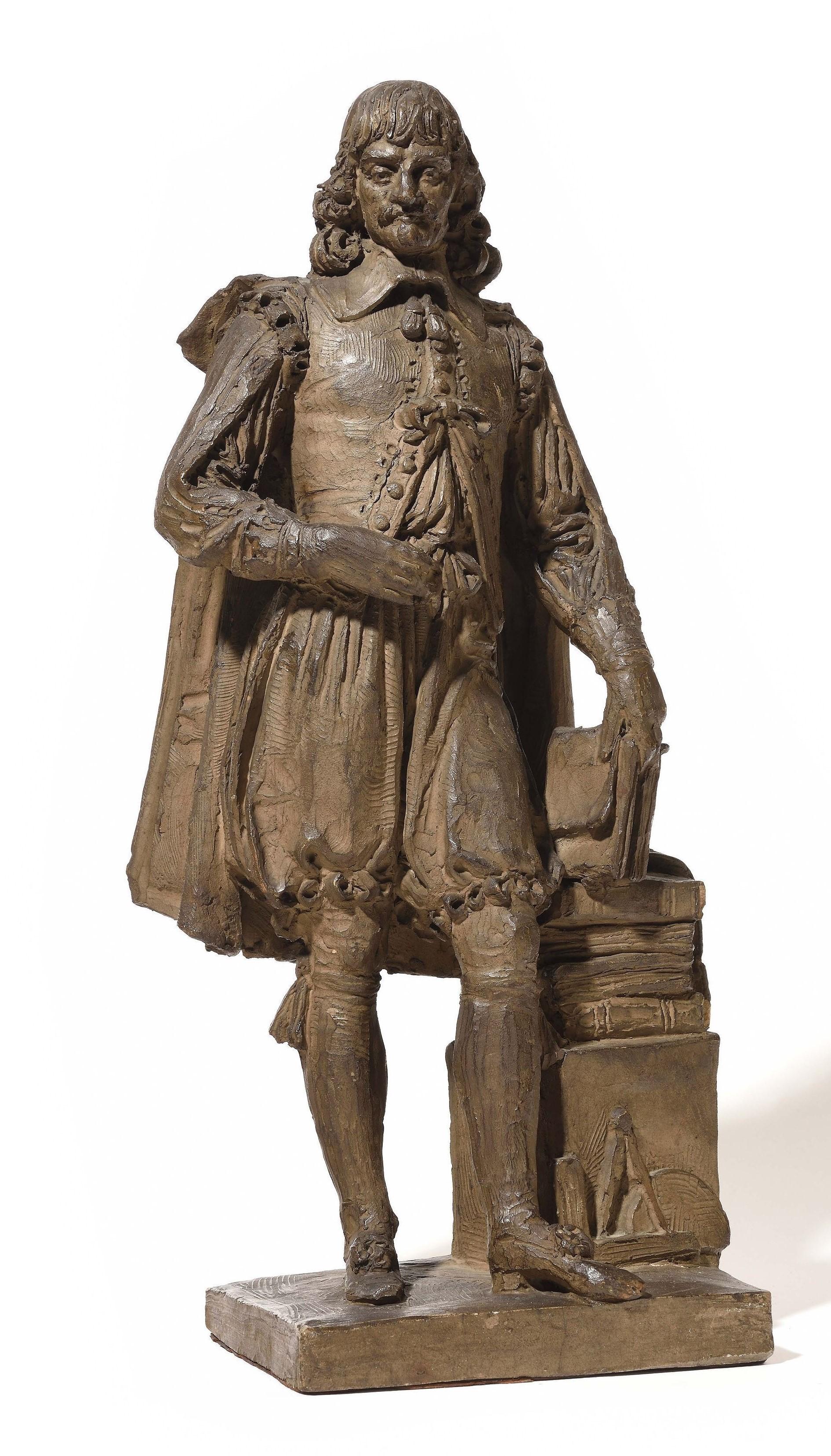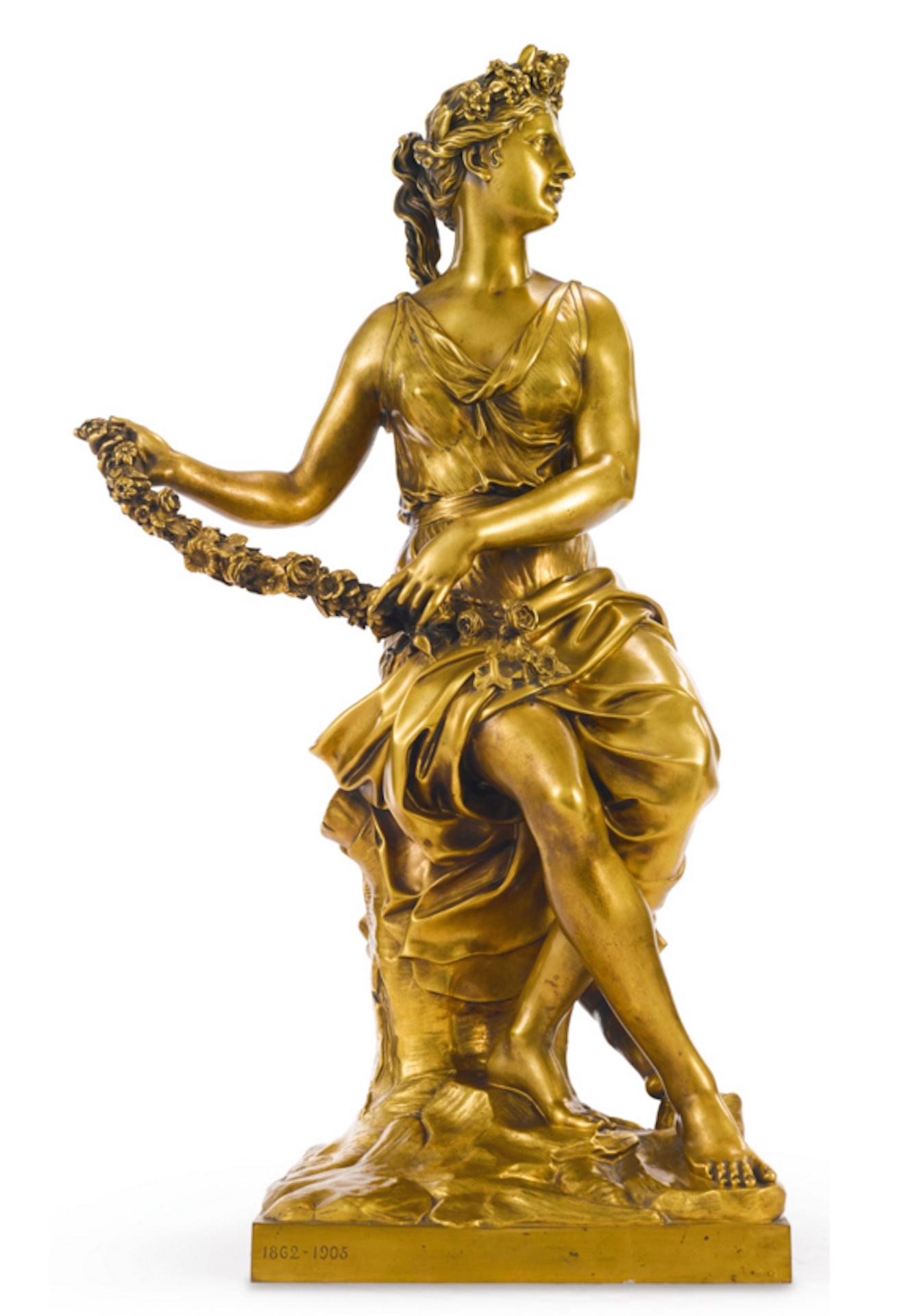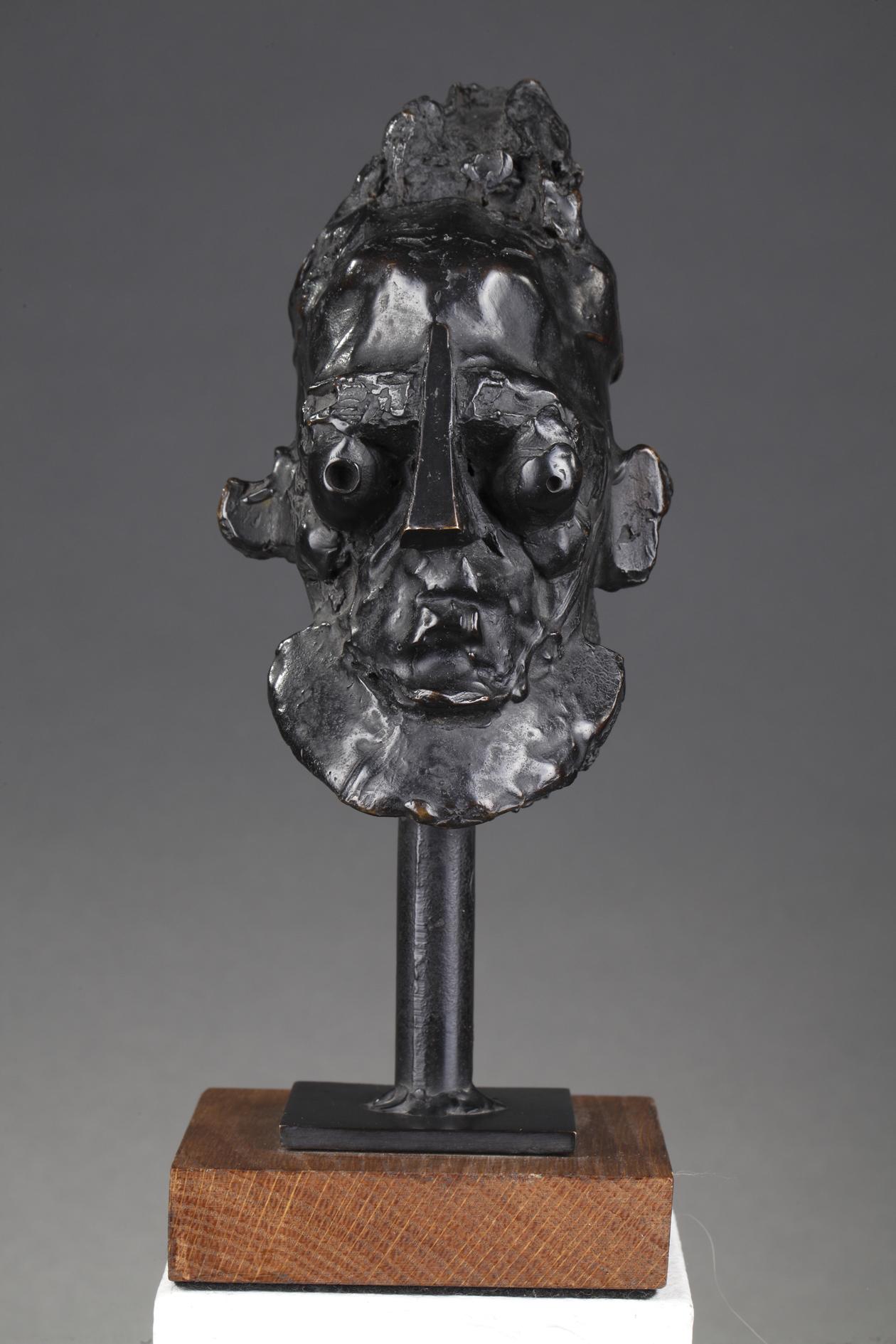Items Similar to General Cambronne bust in "Hermès" - Att. to E-E Suc (1802-1855)
Want more images or videos?
Request additional images or videos from the seller
1 of 5
General Cambronne bust in "Hermès" - Att. to E-E Suc (1802-1855)1842
1842
About the Item
Attributed to Etienne-Édouard SUC
(Lorient, 1802 – Nantes, 1855)
Bust "in Hermès" of General Cambronne
Plaster
H. 59 cm
1842
Provenance: probably Madame Cambronne (1773-1854), widow of the general
Our bust of General Cambronne (1770-1842) could be an interesting rediscovery of a work by the Breton sculptor Etienne-Édouard Suc.
Renowned for his bravery, demonstrated during the revolutionary wars and then during the battles of the Empire and in particular the campaigns in Russia and France, Cambronne had acquired great celebrity at Waterloo, where he heroically commanded the last square of the Imperial Guard. Seriously wounded on this occasion and taken prisoner, he was treated in England by a Scottish nurse, whom he married in 1820. Returning to France at the beginning of December 1815, he was tried in Paris by the new monarchical regime for treason but benefited from a acquittal on April 26, 1816 and returned to his native city of Nantes on May 9, 1816.
His known sculpted effigies, made in the first half of the 19th century, are limited to those of the Debay father and son.
Jean-Baptiste-Joseph Debay (1779-1863), said the father, originally from Mâlines, pupil of Chaudet and living in Nantes since 1801, had, as we can read in the magazine L'Artiste of 1842, "started a bust of this brave general, immediately after the outcome of the trial (therefore in 1816) ... strikingly resembling", The Artist mentioning at the same time 1815 as the date of the beginning of the work ... It is only 'at the Salon of 1853 that the sculptor presented a plaster bust (N°1299), General Cambronne from nature in 1816, followed at the Salon of 1855 by the marble version (N°4323) acquired by Napoleon III; the plaster bust of 1853 was purchased by the State to be placed in Versailles, but there are other posthumous copies in the Royal Museums of Fine Arts of Belgium and the town hall of Mâlines. This bust represents the general in uniform, in an attitude that is both solemn and very dynamic.
This date of 1815 is again indicated by Jean-Baptiste-Joseph Debay (1802-1862), known as the son, when, in order to obtain the order for the statue decided by the city of Nantes in 1842 just after the death of General , put forward the following argument: "I have for the resemblance of the statue a guarantee that no one else can now offer. My father made in 1815 after General Cambronne who came to pose at his home, a bust marked of a striking resemblance and of that beautiful character which my father knows so well how to put into his sculpture... the only portrait made during the lifetime of the general... this bust, my father abandons it to me". This date of 1815 seems to pose a problem, since Cambronne is at the beginning of the year on the island of Elba (he is the military commander), then it is the Waterloo campaign in June, the convalescence in England in the second half , and the return to Paris in December... Would he then have returned to Nantes for a few days between April and June to pose for Debay senior? If his detailed biography (Cambronne; his civil, political and military life by Léon Brunschvicg, 1894) does not mention it (there is, however, a source recounting a day in May when he set out to kiss his elderly mother), it indicates, however, that the bust was probably made during the few weeks that Cambronne spent in Paris in the spring of 1815, thus implying Debay's visit to Paris...
Be that as it may, the (full-length) statue of Debay junior, which was inaugurated in Nantes in July 1848, was strongly inspired by that of his father as far as the face is concerned: the same severe air, fiery hair styled in the identical, favorites very provided. Note that there is a bronze bust (Inv.14.1.9.S), with a presentation in Hermès like ours, signed J. Debay, and acquired in 2013 by the Musée d'Arts de Nantes, of which it is difficult to decide on the paternity between the father and the son.
Concerning our bust, the identity of Cambronne is beyond doubt, if only by the skin growth present on the left cheekbone.
Concerning its author, there are similarities with the effigies of Debay, in particular in the broad treatment of the curls of the hair, and one could think of a first thought, "in the Antique", of Debay father, for his bust of 1816 , before he chose to give it a more contemporary military appearance. However, the much more subdued physiognomy, the less vigorous hair (Cambronne had however kept his curls until his death), the less dense sideburns, and especially the more "heavy" chin and neck, lead us to favor an effigy more Late Cambronne, and by another artist.
However, the biography of Brunschvicg tells us that, in the inventory of the furniture of the widow (who died on January 4, 1854) from Cambronne, there was a bust of the general by Suc, a bust executed in 1842, "from a cast taken on the face of the general. The family did not find him very similar", without e the material (plaster or terracotta) of this bust is specified. Suc was one of the Nantes sculptors who proposed their candidacy for the statue that the city had decided to make only a week after the death of its local glory; he had been able, with Mrs. Cambronne's authorization, to "access" the remains to take a cast, the basis for a bust. Suc said he was "appointed by the family of the illustrious general, to revive his features". But the family, skeptical about the resemblance, asked another Nantes sculptor, Amédée Renard (1806-1879), a pupil of Mahlknecht, to create a terracotta bust (which was still in the family of the adopted daughter of Cambronne). And we have seen that it was finally Debay junior who won the order of the city.
It is quite likely that our bust is the one sculpted by Suc in 1842 and having belonged to the widow of Cambronne. Born in Lorient, pupil in Paris of Henri Lemaire from 1828, Suc exhibited for the first time at the Salon in 1834 and obtained a gold medal there in 1838. He produced a few sculpted genre or religious groups, but he was truly specialized in the portraits, with numerous medallions, but above all a very large quantity of busts, in particular of soldiers (Generals Belliard and Dumoustier, Drouet d'Erlon for example), with a predilection for so-called "Hermès" representations. Steeped in a neoclassical background, his art drew much from ancient tradition, according to an obituary in the 1854 Western Provinces Review.
- Attributed to:Etienne-Edouard Suc (1802 - 1855, French)
- Creation Year:1842
- Dimensions:Height: 23.23 in (59 cm)Width: 15.75 in (40 cm)
- Medium:
- Movement & Style:
- Period:
- Condition:
- Gallery Location:BELEYMAS, FR
- Reference Number:1stDibs: LU1860210111132
About the Seller
No Reviews Yet
Vetted Seller
These experienced sellers undergo a comprehensive evaluation by our team of in-house experts.
Established in 2011
1stDibs seller since 2022
- ShippingRetrieving quote...Ships From: BELEYMAS, France
- Return PolicyThis item cannot be returned.
More From This SellerView All
- Dominique Mahlknecht (1793-1876) The french philosopher René DescartesLocated in BELEYMAS, FRDominique (Johann Dominik) MAHLKNECHT (Kastelruth, 1793 - Paris, 1876) Full length portrait of René Descartes Terracotta with brown patina Height: 40cm ...Category
1840s French School Figurative Sculptures
MaterialsPlaster
- Charles Merme (1818-1869) The blessing of Coureau de Groix in Larmor BrittanyLocated in BELEYMAS, FRCharles MERMÉ (Cherbourg 1818 - Lorient 1869) The blessing of Coureau de Groix at Larmor Oil on canvas H. 60 cm; W. 100 cm Signed and dated lower left, 1...Category
1860s French School Figurative Paintings
MaterialsCanvas, Oil
- French King Louis-Philippe - After Baron GérardLocated in BELEYMAS, FRAfter Baron Gérard, circa 1835 Portrait of King Louis-Philippe Oil on canvas H. 79 cm; L. 65 cm Provenance : Private collection, Périgord, by descent since the 19th century This po...Category
1830s French School Figurative Paintings
MaterialsCanvas, Oil
- Maurice Lobre (1862 -1951) The snackBy Maurice LobreLocated in BELEYMAS, FRMaurice LOBRE (Bordeaux 1862 - Paris 1951) Le goûter Huile sur toile H. 87 cm ; L. 91,5 cm Format peint d’origine, H. 101 cm ; L. 96 cm, disposé sur un châssis plus petit par l’artiste lui-même. Signée et datée 1888 en bas à droite Provenance : Collection privée, Lyon Exposition : 1889, Salon des Artistes Français, n°1719 « Intérieur », (ou 1720 nommé également « Intérieur ») Œuvres en rapport : Le Cabinet de toilette de Jacques-Emile Blanche, (titre erroné) H. 80 cm ; L. 85 cm, HST, Museo Thyssen-Bornemisza, Madrid, pendant de notre toile. Maurice Lobre a-t-il connu Marcel Proust ? On ne peut encore l'affirmer, bien qu'il ait eu de nombreux amis en commun avec l'écrivain. Mais sa peinture intimiste pourrait illustrer certaines pages de Du côté de chez Swann. Trois citations dues à des proches de Proust, l'une de l'écrivain Léon Daudet, la seconde du peintre Jacques-Emile Blanche, la dernière du poète mondain Robert de Montesquiou, donnent un aperçu de ce que fut la renommée de Maurice Lobre en son temps : "Il en va autrement de Lobre, le Vermeer français, le peintre exquis des intérieurs et des palais de Versailles, des reflets sur les meubles rares, de la lumière prisonnière des miroirs, des laques et des cuivres polis. Lobre est joyeux comme un coup de vent, qui fait envoler les préjugés et les poncifs, éloquent, passionné, ivre de la couleur et des formes, charmant et conquérant de toutes les matières. Il se promène ici-bas ainsi que dans un musée en plein-air, s'amuse de tout, rejette et maudit le laid et le vil, accueille et bénit le beau et le bien…" Léon Daudet L'Entre-deux-guerres. Souvenirs des milieux littéraires, politiques, artistiques et médicaux de 1880 à 1905. "Voici le patient, appliqué, sage M. Lobre. Il est difficile de mettre plus d'honnêteté à peindre des intérieurs sans figures. Je préfère ses petits salons de Versailles à ses cathédrales… Nous lui devons des petits bijoux d'émotion et de large fini." Jacques-Emile Blanche "Il a recueilli sur des toiles le visage du vieux Versailles (…). Il a peuplé de visions impalpables des chambres " où il s'est passé quelque chose ", et il en a saturé l'atmosphère de particules historiques. Donner une telle impression avec certitude, avec vérité, c'est plus difficile que de faire évoluer des personnages costumés, dans ce qu'on appelle bêtement "une reconstitution historique"." Comte Robert de Montesquiou Maurice Lobre commence sa carrière au Salon de 1882 où il expose deux portraits, dont celui de son camarade de l'atelier Carolus-Duran, le peintre espagnol Ramon Casas...Category
1880s French School Figurative Paintings
MaterialsCanvas, Oil
- François-Joseph Kinson - Young woman portrait with her dogBy Francois Kinsoen (Kinson)Located in BELEYMAS, FRFrançois-Joseph KINSON (Bruges 1770 – Bruges 1839) Portrait of a young woman near a spring, accompanied by her dog Oil on canvas H. 73 cm; L. 60 cm circa 1815-1817 We owe this elegant portrait to François-Joseph Kinson from Bruges, which is still linked to the art of the First Empire. We find in this artist this type of pose that is a bit rigid, sometimes with a countryside in the background, and this way of treating costumes and faces. Thus the full-length portrait of Jenny...Category
1810s French School Figurative Paintings
MaterialsCanvas, Oil
- French school c.1815 - Portrait of a young boyLocated in BELEYMAS, FRFrench school circa 1815 Portrait of a young boy Oil on canvas H. 84 cm; L. 70 cm Provenance: Señor Valdes Fauri Collection, Madrid around 1900/1950; then Private collection, Bordea...Category
1810s French School Figurative Paintings
MaterialsCanvas, Oil
You May Also Like
- Friendship, comfort: hand modelled sculpture by Polish Jewish French artistLocated in Norwich, GBAn extraordinary depiction of friendship and comfort by Polish Jewish sculptor Michal Michael Milberger. Milberger was born in Warsaw in 1922. His artis...Category
Late 20th Century French School Figurative Sculptures
MaterialsPlaster
- Flora et L'amour ou HamadryadeBy Ferdinand BarbedienneLocated in Tallinn, EEFerdinand Barbedienne (1810 - 1892) Antoine Coysevox, after (France, 1640-1720) Flora et L'amour ou Hamadryade Inscribed 'A. COYSEVOX. F. 1710'. With foundry mark 'F. BARBEDIENNE...Category
Late 19th Century French School Figurative Sculptures
MaterialsBronze
- Lion and snakeBy Antoine-Louis BaryeLocated in PARIS, FRLion and snake n°3 by Antoine-Louis Barye (1796-1875) Bronze sculpture with a nuanced dark greenish brown patina signed "Barye" on the base old edition cast – probably from the Bary...Category
1860s French School Figurative Sculptures
MaterialsBronze
- The SpringBy Albert-Ernest Carrier-BelleuseLocated in PARIS, FRThe Spring by Albert-Ernest CARRIER-BELLEUSE (1824-1887) Sculpture made in white Carrara marble signed on the base "A. Carrier-Belleuse" France circa 1870 height 76,5 cm width 30 cm depth 24 cm Biography : Albert-Ernest Carrier de Belleuse known as Carrier-Belleuse (1824-1887) was one of the most prolific artists of the century and had the greatest successes under the Second Empire, enjoying the personal support of Napoleon III. His work was greatly influenced by the style of the Italian Renaissance and that of the 18th century, which he helped to bring up to date. In 1837, the young Carrier-Belleuse apprenticed in the workshop of the engraver Bauchery. He was admitted soon after to the goldsmith Jacques Henri Fauconnier. Through François Arago, he met the sculptor David d'Angers who facilitated his admission to the School of Fine Arts. Carrier-Belleuse entered it in 1840. Noted for his skill by the great bronze companies in Paris such as Barbedienne and Denière, he soon received numerous orders for models for candelabras, pendulums, fittings for fireplaces, etc. In 1848, probably at the initiative of François Arago, who became head of state, he received his first public order for a small statue of "Mademoiselle Rachel singing La Marseillaise". In 1851, he appeared for the first time at the Salon of French Artists, where he presented two bronze medallions. From 1851 to 1855, Carrier-Belleuse stayed in England, in Stoke-on-Trent where he served as director of the modeling and drawing school of the Minton house, a large porcelain manufacturer. Back in France, Carrier-Belleuse moved to Paris in a large workshop located 15 rue de la Tour d´Auvergne. From 1857, he made regular sendings to the Salon and became famous thanks to the success of large marbles, such as the "Bacchante" exhibited at the Salon in 1863, and acquired by Napoleon III, "Angelica" (1866) or even "Hebe asleep" (1869). At the Salon of 1867, his group entitled "Messiah" earned him the medal of honor of sculpture. It was acquired by the State to adorn the Chapel of the Virgin in the Saint-Vincent-de-Paul church. Carrier-Belleuse acquired a great reputation in parallel for his terracotta busts which, in many respects, recall those of 18th century artists. He made portraits of a large number of celebrities of his time. He produced, among others, the busts of Napoleon III, Renan, Thiers, Grévy, Arago, Marguerite Bellanger, Théophile Gautier, Honoré Daumier, Delacroix, Hortense Schneider, Réjane… He also modelled numerous busts of mythological inspiration and historical and artistic portraits like Marie Stuart, Shakespeare or even Mozart. Carrier-Belleuse used and trained in his workshop in the rue de la Tour d´Auvergne many young talented artists such as Alexandre Falguière, Jules Desbois, Eugène Delaplanche, Jules Dalou or Joseph Chéret; but he was best known for having been the master of Auguste Rodin who entered his studio as a practitioner in 1864. Carrier-Belleuse devoted himself a lot to decorative sculpture. He contributed to the decorations of many important buildings. We owe him in particular the caryatids of the Renaissance theater in Paris, the pediment of the main entrance to the Banque de France, the stucco ceilings of the Lesdiguières and La Trémoïlle pavilions at the Louvre Palace, the frieze of the Palais de la Bourse in Brussels, or the decoration of the Hôtel de la Païva on the Champs-Elysées in Paris. He also received State commissions for monuments: that of Jean-Jacques Rousseau in Montmorency, of Alexandre Dumas, in Villers-Cotterêts, of Masséna in Nice. Abroad, he produced the equestrian statue of Michael the brave in Bucharest and the tomb of José de San Martín in Buenos Aires. In 1873, Carrier-Belleuse took part in the construction of the Paris Opera house, directed by his friend Charles Garnier. He created the two monumental torchieres...Category
1870s French School Figurative Sculptures
MaterialsMarble
- Man's headLocated in PARIS, FRLaurent Belloni (né En 1969) Man's head Bronze cast with a nuanced black patina Signed "Belloni" on the foot Foundry mark "Susse fondeur Paris" numbered 1/8 France around 1996 hei...Category
1990s French School Figurative Sculptures
MaterialsBronze
- PheasantBy François PomponLocated in PARIS, FRPheasant by François Pompon (1855-1933) Exceptional bronze with old gilded patina Cast by Valsuani Period cast France circa 1930 height 8,2 cm length 14,2 cm width 3,6 cm A simila...Category
1930s French School Figurative Sculptures
MaterialsBronze



